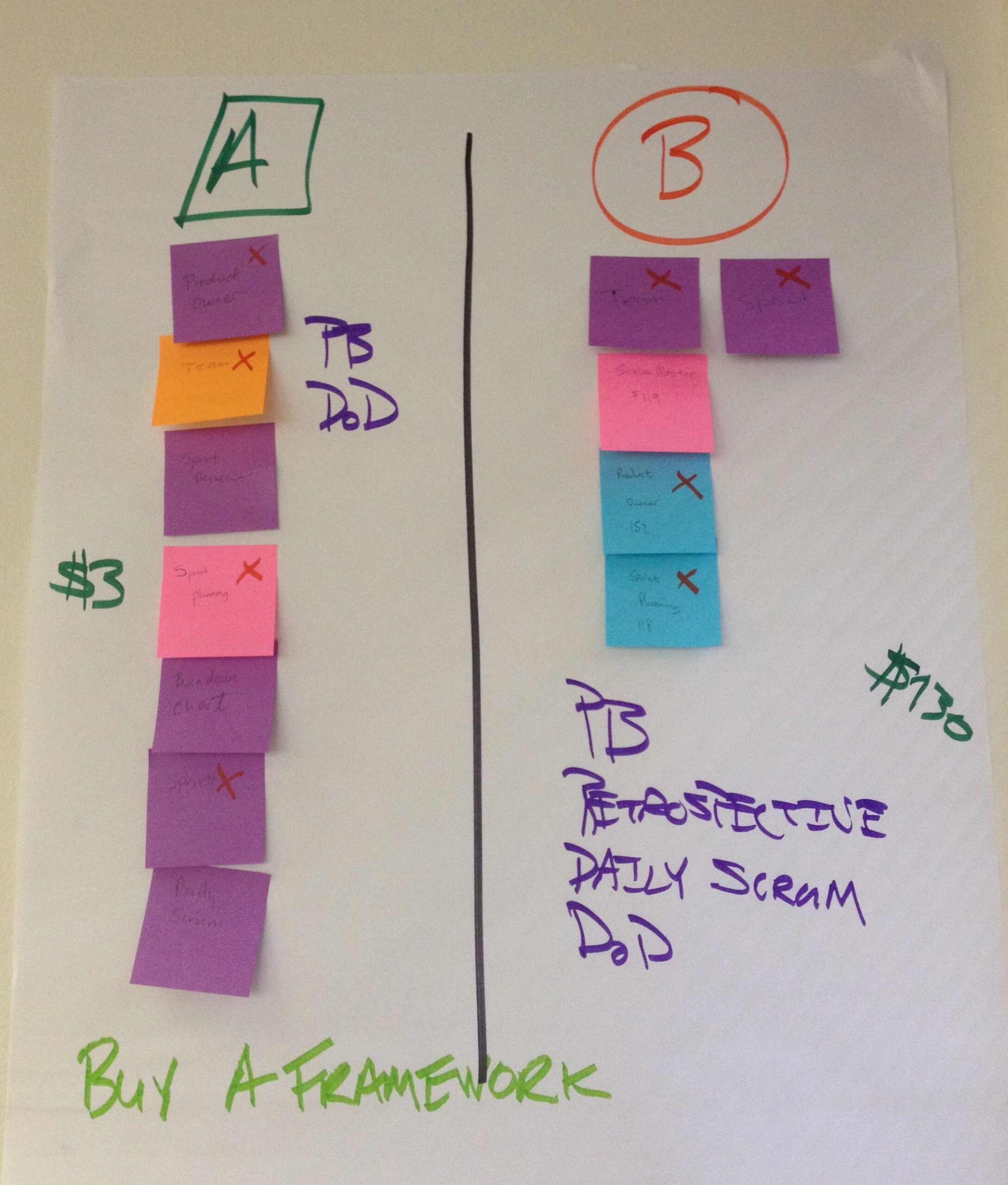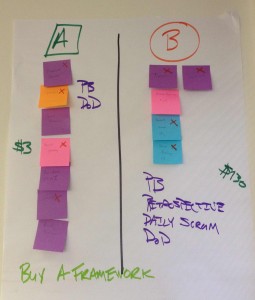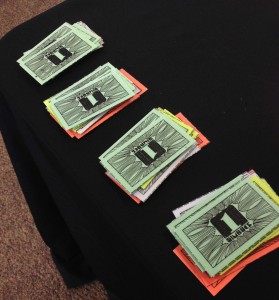
Introducing Scrum: Buy a Framework game
Today I am going to share with you a engaging , interactive and brief exercise I use to teach Scrum in the first twenty minutes of my Certified ScrumMaster or a basic one-day Intro to Scrum class. The game is called Buy a Framework and is based on the classic Innovation Game, Buy a Feature. In my experiences teaching, unless I introduce all the pieces of Scrum within the first twenty minutes, the learners tend to get anxious and tend to drive their questions and interactions with me towards a description of Scrum.
For a while, I struggled with this since while Scrum is generally considered easy to understand, it is a complex and subtle framework. IMO, to dive right into Scrum without building a learning community and establishing some basic classroom interactions makes it more difficult to talk about the underlying issues why Scrum is hard. In 2012, I had the opportunity to co-train with Jason Tanner and I came up with this nice application of Buy a Feature as a learning tool to teach Scrum. If you find this game useful or perhaps interesting, then feel free to download the one-page PDF on the Resources section of my website and use this game to help teach Scrum in your organization.
The Buy a Framework handout is rather uncomplicated. It lists the entire Scrum framework on one page. In addition, the spreadsheet layout is easy to scan and the cells contain the essential information anyone needs to understand the basic pieces of Scrum. Each row identifies a component (or feature) of Scrum, provides a one-sentence definition of each piece of the framework, offers a short summary of the benefits the component provides and a cost. The cost is an element you need to play the game, but the rest of text is pure Scrum.
In order to play the game, divide the participants into groups of four to eight people. Each person will need some type of play money (Monopoly or Payday or make your own) in order to make their purchases. I recommend taking the total amount of money needed to purchase all the items ($936), divide by two and then equally distribute the remaining to each player in the group. Rounding up or down in the case of fractions does not matter.
These are the rules to Buy a Framework:
- Based on what you know right now, you have ten minutes to buy the pieces of the Scrum framework you think are most important.
- To purchase a component, write the name of the item on an index card or post-it note (one per post-it note or index card) and place your money on top of the index card or post-it note.
- To unpurchase a component, take your money back and tear up the index card and post-it note.
- You can only buy a component once and there is no benefit to purchasing an item multiple times.
- There is no benefit to having money leftover at the end of the game and you are not required to spend all your money if you do not wish to.
- If you choose, you can pool your money with one or more participants in your group in order to buy more components. Nothing in the rules says you must share your money nor are you prohibited from sharing your money. The choice to share the money is up to each player.
- You cannot pool your money with a player (or players) in another group (or groups).
Once the rules are explained and the basic questions are answered, players have ten minutes to make their purchases. The early minutes will be spent reading the handout and discussing on how to get started. During these early conversations, players will discover they do not have enough money to buy everything they want and the really desirable items in the Scrum framework are beyond the purchasing power of a single player. As a result, the participants begin to have a conversation about what are their true priorities and what pieces of Scrum they think are essential. What makes Buy a Framework so powerful as a teaching tool is that the experienced learners begin to explain the pieces and benefits of Scrum to the inexperienced learners in words, language and experiences they are familiar with.
 At the end of the ten minutes, the participants will have made their purchases. To facilitate the sharing of the game results, I recommend taking the index cards or post-it notes and taping them to a piece of chart paper. Ask the participants why they purchased their items or what made this collection of components more desirable than the items they did not purchase. Look to see if the participants can identify a theme that unites their purchases. Sometimes it is interesting to ask the players if there was one more item they could buy – money being no object – what additional item would they purchase. Complete this debrief for each group. Note similarities and differences between the purchases of the different groups. Ask the participants if they can identify and connections between the purchases of the different groups.
At the end of the ten minutes, the participants will have made their purchases. To facilitate the sharing of the game results, I recommend taking the index cards or post-it notes and taping them to a piece of chart paper. Ask the participants why they purchased their items or what made this collection of components more desirable than the items they did not purchase. Look to see if the participants can identify a theme that unites their purchases. Sometimes it is interesting to ask the players if there was one more item they could buy – money being no object – what additional item would they purchase. Complete this debrief for each group. Note similarities and differences between the purchases of the different groups. Ask the participants if they can identify and connections between the purchases of the different groups.
So why does Buy a Framework\Buy a Feature work? There are two crucial elements to understand in this game.
- Scarcity – scarcity is very important in this game. IME, providing each group enough money to buy between 45% to 55% of the total items is good numbers to use. Without scarcity, the conversations around what are the essential pieces of Scrum will not occur. If they have too much money, participants will not discuss the trade-offs associated with purchasing or not purchasing components. On the other hand, if you have too little money, then the players only talk about their top one or two essential needs. Without some excess resources, we cannot explore what are the second- and third-tier priorities. In both cases, when there is too much or too little money, the conversations tend to be very short.
- Pricing – in this game, cost is used to signal the importance of an item. Items that might be considered highly desirable to the players and\or might be considered important to Scrum are priced beyond the purchasing power of a single individual. The high cost of these components encourages participants to share their experiences on why the component is important to them or essential to a successful application of Scrum. In their conversations, participants may solicit other players for money in order to purchase the an expensive item. Sometimes, players will hear something that might cause them to change their mind. These interactions, brought about by the different prices, encourages peer-to-peer sharing and amplifies learning.
The only weakness this game has is that it gives the impression one can pick-and-choose the pieces of Scrum to apply in your environment. While each piece of Scrum can provide individual benefits, Scrum is designed to be used as a complete framework. I often say that Scrum is the minimum framework needed to produce a high-quality product that can change over time and there is not much left to remove. IME, removing pieces diminishes the ability to provide feedback , delays the learning your organization needs to be effective and introduces a great deal of risk to your product development efforts.






